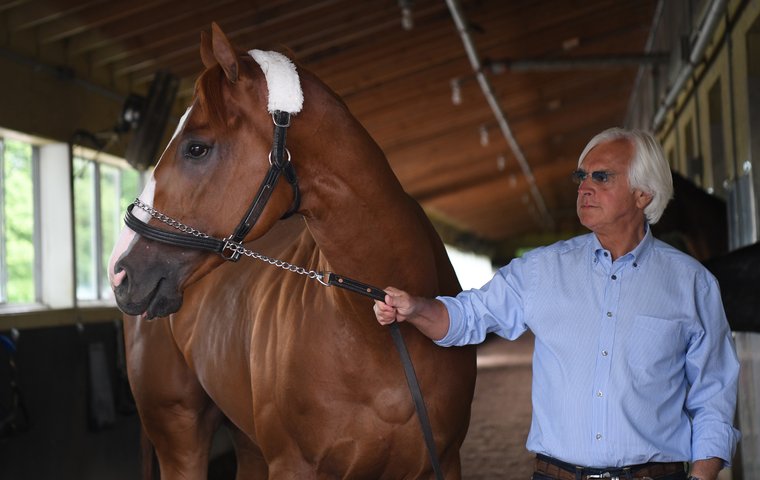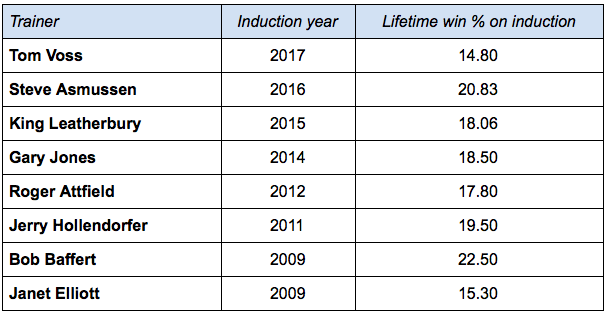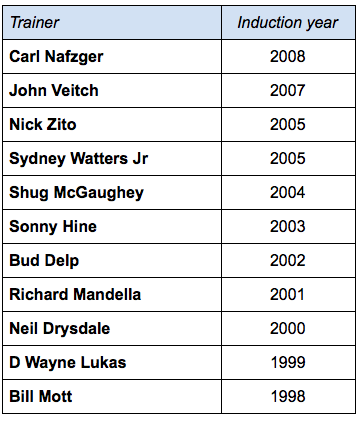
If you are reading this, you already know that Justify tested positive for the drug scopolamine after winning the Santa Anita Derby before going on to win the Triple Crown. The California Horse Racing Board (CHRB) never explained to the racing public what had happened. We only learned about this development 15 months after the fact thanks to this article by Joe Drape in the New York Times last week (September 11).
From my perspective, this was not handled appropriately by the CHRB, but, in my view, Baffert and Justify do not figure in the real story, which does need further explanation.
According to Drape, the CHRB took more than a month to confirm the results. Instead of filing a public complaint, the board made a number of decisions in private, dropped the case against Justify and modified the rule regarding scopolamine, finding that Justify and a “handful” of other horses had eaten jimson weed, which contains scopolamine. It should be noted that scopolamine cases have resulted in disqualifications, purse reimbursements, fines and suspensions over past decades, according to Drape.
Information that was not revealed
There are procedural steps that the staff and board of the CHRB undertook that are material to the Justify case that can be questioned, but more importantly one has to understand what actions were taken and why?
For example, Drape writes the following
Dr Rick Sams, who ran the drug lab for the Kentucky Horse Racing Commission from 2011 to 2018, said scopolamine can act as a bronchodilator to clear a horse’s airway and optimize a horse’s heart rate, making the horse more efficient. He said the amount of scopolamine found in Justify - 300 nanograms per milliliter - was excessive, and suggested the drug was intended to enhance performance. “I think that it has to come from intentional intervention,” he said.
The CHRB staff offered no information about the other horses that may have been contaminated. They did not give their names or those of their trainers?
Was the contamination that the board asserted for the unnamed horses consistent with the 300 nanograms alleged to have been found in Justify. Were there more environmental results that the staff chose not to share with the public?
This event was especially troubling for me, because I have written on numerous occasions how ineffectual and unprofessional many state racing regulatory agencies are and how poorly they collectively serve the Thoroughbred racing industry. I had always considered the CHRB to be one of the better ones. However, this, along with the serious issues that Santa Anita faced this winter, convinces me that we need a centralized national organization to manage integrity issues that are stipulated in the Horseracing Integrity Act of 2019.
Need for out-of-competition testing
One of the most important initiatives that will have to be addressed head on by USADA (U.S. Anti-Doping Agency) is the dramatic need we have in the U.S. for Out-of-Competition Testing (OOCT). In fact one of the first jurisdictions in the U.S. to take on OOCT was California and the CHRB.
California first focused on the logistics of developing the proper program and policies. Keep in mind, that OOCT may conjure up images of vets, trainers and CHRB staff traveling all over the state. In fact, OOCT will test a number of horses that are stabled and train on track, but the goal is to test these horses on a random basis to capture proper results that simply cannot be captured in a traditional post-race test.
California developed its original plan focusing on the mechanics on how the horses were going to be selected and tested with results on a timely basis. Dr Rick Arthur, Equine Medical Director of the CHRB, has done a brilliant job developing the expanded program, incorporating all aspects, including penalties, and has gotten tremendous pushback from the TOC (Thoroughbred Owners of California) and the CTT (California Thoroughbred Trainers).
The U.S. is far behind the rest of the racing industries around the world regarding OOCT. In the U.S., OOCT is approximately one percent of the drug tests that are conducted. That compares very unfavorably the other major racing jurisdictions, which are a minimum of ten percent, and in most countries closer to 20 percent. In the U.S., OOCT for baseball is 25 percent and for swimming and cycling it is 60 percent.
Why is OOCT so important? The racing industry has been led to believe by the current constellation of vets, trainers and regulators that post-race testing catches the cheaters.
IT DOES NOT!
Peter Sacopulos is a lawyer and former operator of Green Gables Stud in Clay County, Indiana, and he wrote a brilliant article on OOCT for the National HBPA Horsemen’s Journal, Summer 2013 issue, in which he says:
“Out-of-competition testing aims to detect prohibited substances, primarily blood-doping agents, that are not detectable in post-race tests [and] that are specifically identified and prohibited by regulation and/or rules. Many of the substances targeted by out-of-competition testing are detectable for only a short period of time after being administered to the horse. In short, a horse administered a blood-doping agent prior to race day may test negative in a post-race test but may have received the potentially positive race-performance effect of the prohibited substance.”
The best of the best
Many of the new blood-doping agents and synthetic drugs fall into this category. Put simply, post-race testing accounts for 99 percent of the test samples that we collect in the U.S. The American racing industry is spending large sums of money to catch cheaters by concentrating on post-race tests. Even if we had new state-of-the-art labs with enhanced testing procedures, we would have virtually no chance of catching the cheaters without a rigorous out-of-competition testing and rigorous enforcement initiatives.
Okay, I have written a great deal about cheaters, which may lead you to ask, how does Hayward know that there is all this cheating going on in our sport? Let’s do a brief math exercise that will provide you some tools for your own use. Let’s go back over the last ten years of contemporary trainers elected to the National Museum of Racing and Hall of Fame:

Here is the previous decade of Hall of Fame Inductees:

The National Museum and Hall of Fame did not have any trainer winning percentages for the last group of trainers. However, I would speculate that the overwhelming majority of these Hall of Fame trainers, the ‘best of the best’, will have a win percentage of 17-20 percent. These are some of the great trainers of this generation, which would indicate that consistent winning success over 20 percent is extremely rare to achieve.
In trying to identify a pool of possible trainers for a new program of OOCT, I would suggest using the trainer stats from the Daily Racing Form and prioritizing those trainers that have achieved and maintained over three to six months a percentage of 25 percent or higher in the following categories:
- First time starters in both MSW or MCL
- First back off a layoff of 90 or more days
- First race off a claim
- Race after a win
In addition to this targeted list of possible cheaters, a broader program for the remaining trainer base would need to be developed.
While we are on the topic of dealing with cheating by trainers in a small portion of our races across the country, the Daily Racing Form conducted an extensive survey of betting customers in October 2015. These three questions from that survey represent important betting and integrity issues:
Do you believe states are currently effectively catching trainers or veterinarians who are using illicit drugs?

Do you believe states are capable of adopting uniform medication rules without the structure that would be imposed by the Thoroughbred Horse Racing Integrity Act?

Are you in favor or opposed to passage of the proposed Thoroughbred Horse Racing Integrity Act?

Please remember that DRF customers are generally serious bettors who apparently continued making bets even when 78 percent of them believed that illicit drugs were being used on the racehorses. Also, pari-mutuel in the U.S. reached a high point of $15.18 billion in 2003 and has flattened out at $11.27 billion in 2018 (a decline of 25.8 percent). I know from my own experience, when I find myself trying to handicap the cheaters instead of the horses, I lose interest and confidence in the amount that I wager.
In turning back to the regulatory environment, I do want to mention a few issues regarding the work of the then New York State Racing and Wagering Board when I worked at NYRA and the experiences of a student of the New York Gaming Commission.
During the late 2000s, when I was working at NYRA, I experienced something truly remarkable.
During the pre-race activities when the horses walked into the paddock area before saddling, the NYRA vet responsible for the paddock spotted a horse with a small needle mark with blood on its neck. The vet quickly called the head of security, who immediately checked the trainer’s premises and found one full syringe and one empty one. That already was a serious violation of NYRA rules.
The security head escorted the trainer to the state steward’s office. The trainer signed a statement saying that the syringes belonged to him, but then he would talk no further.
We sent the material off to the NY Racing and Wagering Board exec, asking for him to inspect the needles for their content, test some blood that was drawn from the horse and inform us how he planned to proceed. We sent everything off and waited to hear from the Racing and Wagering Board. The call never came. Nor did I ever get my phone call returned.
Clearly the NY Racing and Wagering Board was not interested in catching a cheater that day.
We have been fortunate to have Tom Noonan write for this site. Tom is a lawyer, breeder, owner, bettor and student of NYRA and New York racing politics. Last summer, Noonan wrote this excellent article, Does New York care about horses being doped? He wrote:
“New York’s lackadaisical attitude towards OOCT is particularly disturbing for a number of reasons:
- It typically takes 20 percent of the national betting handle, meaning bettors cannot be confident they are getting an honest product.
- Transparency is always a beneficial characteristic, but even more so in a business where suspicions and rumors tend to be rampant.
- Disclosing the identities of trainers and horses who have been tested would be a benefit to all, but particularly to those of the ‘knowing whispers’.
- Publishing data on testing is the most effective deterrent there can be.
My fear, however, is that New York’s program - to the extent that it even exists - is nothing more than a sham. How can it be that not a single Thoroughbred tested positive over a period of more than four years.”
I have come to believe that no one in the state regulatory offices, in the executive offices of the racetracks, and certainly not the trainers nor the vets want to catch the cheaters.
The system is broken, and, if it is not replaced, the Thoroughbred racing industry has no future.
Similarly, I think that the time has come for leaders in the racing industry to accept the fact that the Racing and Medication Consortium (RMTC), the Association of International Racing Commissioners (ARCI) and the state regulatory/racing commissions have failed to provide leadership and direction for the integrity of the Thoroughbred racing industry.
‘A disservice to the sport’
Certainly, on the part of the RMTC, excellent work was accomplished by talented staff, while executives and board members worked hard on the critical goals and initiatives. However, for example, this group has been working since 2012 to organize the National Uniform Medication Program (NUMP). This initiative was a critical component of harmonizing rules and medications across the country. After seven years, less than half of the 32 horse racing states have adopted the plan, with no indication that a national uniform program will be accomplished. The results for promulgating a national OOCT program have been more disappointing.
Natalie Voss wrote this excellent article on this topic on the Paulick Report in which she asks Joe Gorajec, 25-year former Executive Director of the Indiana Horse Racing Commission, “What is stopping the states from out-of-competition testing?”
“It is either the lack of funding or a lack of will or the combination of both,” he told her. “Without out-of-competition testing, horsemen can cheat with impunity. This is a disservice to the sport and the betting public.”
As I sit here finishing this article, Keeneland has finished a very strong opening week of the September sale. I am pleased that things are performing well on the breeding side of the business. I am afraid, on the racing, wagering and integrity fronts, we are in a serious state of decline, whatever the numbers say.
The Horseracing Integrity Act of 2019 provides a serious positive alternative to what the state regulators can do for the business, and USADA’s history and experience would give us a fighter’s chance to take the betting business back from the cheaters.


